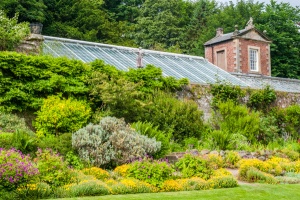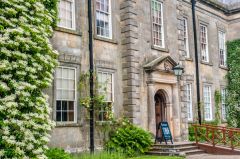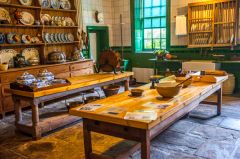
Blackett's new house consisted of four wings around an inner courtyard. The upper floor was reached only by ladder and there were no internal divisions. Blackett loved to socialise, and threw regular parties at Wallington. The parties must have been quite spectacular, for he employed no less than six strong men to carry himself and his guests to bed after they had drunk themselves into a stupor.
Not surprisingly, Sir Walter left the estate in debt, but his heir, Sir Walter Calverley Blackett, was better with his money. This second Sir Walter transformed Wallington, adding inner staircases and suites of rooms on the first floor.
He was also responsible for the landscape gardens, which draw inspiration from the work of Lancelot 'Capability' Brown. The link is more than coincidence, for the young Brown attended school at the estate village before going on to make his name as the foremost landscape garden designer to the nobility of 18th century England. Brown almost certainly helped design the pleasure grounds surrounding Rothley Lake, and perhaps helped lay out the woodland walks near the house.
In 1777 the Blackett line died out and the estate passed to the Trevelyan family, who created a magnificent walled garden, reached by sinuous paths through the woodland. Sir Walter Trevelyan was an avid plant collector and he gathered a collection of rare species from around the globe.
During the late Victorian period, Lady Pauline Trevelyan turned Wallington into an artistic centre, drawing figures in the arts and literature to her north of England home, among them leading lights of the Pre-Raphaelite movement and radical liberal political thinkers from John Ruskin to poet Algernon Swinburne.
That radical thinking found its greatest exponent in the form of Sir Charles Trevelyan, who in the 1940s decided that private ownership of land was objectionable, so he disinherited his family and give the Wallington estate to the National Trust. One doubts the more conservative members of his family were impressed by his decision.
The exterior is restrained, but not so the interior, which is a splendid example of ebullient rococo plastering. In the grounds is a walled garden, which features a conservatory, and a wide selection of plant varieties.

The grounds offer the opportunity for long walks, and there are a series of walks leaflets available explaining the routes. Wallington possesses the largest farm shop of any National Trust property in the northeast of England, and the shop is open all year, offering local produce including, meat, game, organically milled flour, baked goods, and smoked Craster salmon among other taste-tempting treats.
Highlights
Though the interior is beautifully furnished throughout, one part of the house outshines the rest; the amazing central hall, or atrium, at the centre of the building. This space was originally open to the elements, designed as a courtyard surrounded on all four sides by wings of the house.
In the 19th century, Lady Pauline Trevelyan decided to put a roof over the courtyard, and artist William Bell Scott was called in to paint the walls with a series of vivid Pre-Raphaelite scenes depicting great moments in the history of Northumberland.
The result is a triumph of Pre-Raphaelite art, a colourful and vividly refreshing Victorian idealised vision of history, from the age of Celtic saints to the industrial revolution in the north. One panel shows the building of Hadrian's Wall, another the famous scene of Grace Darling and her father heroically rowing to save stranded sailors off the Farne Islands.
Though Bell performed most of the painting, one panel was done by John Ruskin. This is oddly the least satisfying part of the room, and one reason may be that Ruskin and Bell did not see eye to eye, and a room steward confided to me in hushed tones that she suspected Ruskin of intentionally creating something designed to undermine the effect of Bell's vision. If Ruskin attempted to make the central hall less impressive, he failed; it is stunning, one of the most satisfying examples of Pre-Raphaelite art I've seen in Britain.
Another Pre-Raphaelite friend of the Trevelyan family was sculptor Thomas Woolner, who created the striking sculptures in the entrance hall. The rest of the interior features collections of paintings, ceramics, period needlework and a wonderful collection of antique dollhouses.
One wonderful feature is a series of tapestries woven by Lady Mary Trevelyan. The grounds are open from dawn to dusk, year-round, and the walled garden is also open year round. There is also an ongoing programme of events, including music, dance, and open-air theatre.
THE HOUSE


Wall painting in the hall
THE WALLED GARDEN










 We've 'tagged' this attraction information to help you find related historic attractions and learn more about major time periods mentioned.
We've 'tagged' this attraction information to help you find related historic attractions and learn more about major time periods mentioned.



